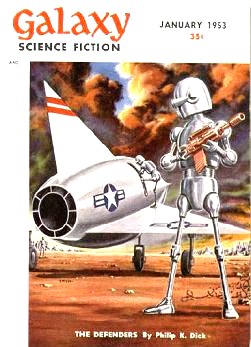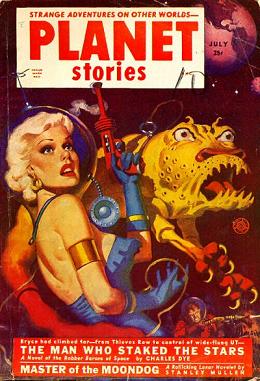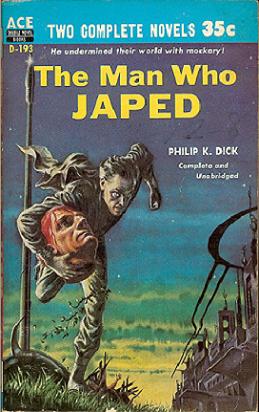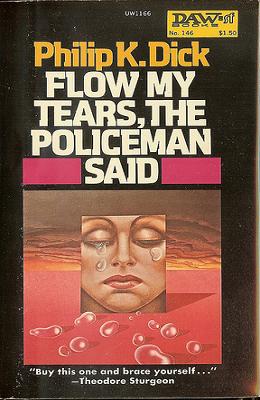
 Philip K. Dick (1928-1982) saw “The Defenders” published in the January 1953 issue of Galaxy (cover top right). It was his fifth published story. His first published story was “Beyond Lies the Wub,” which appeared in the July 1952 issue of Planet Stories (cover lower right). During the 1952-53 period Dick would sell 67 stories, 63 of them appearing in 1953 alone. Certainly some sort of record, for marking his first published story in the middle of 1952 through those seeing print in 1953, in roughly 78 weeks he not only wrote but sold 67 stories, making this close to a story a week written, sold, and published in a year and a half.
Philip K. Dick (1928-1982) saw “The Defenders” published in the January 1953 issue of Galaxy (cover top right). It was his fifth published story. His first published story was “Beyond Lies the Wub,” which appeared in the July 1952 issue of Planet Stories (cover lower right). During the 1952-53 period Dick would sell 67 stories, 63 of them appearing in 1953 alone. Certainly some sort of record, for marking his first published story in the middle of 1952 through those seeing print in 1953, in roughly 78 weeks he not only wrote but sold 67 stories, making this close to a story a week written, sold, and published in a year and a half.
Dick led a tumultuous life. He married five times, fathered several children, early in his career experimented with hallucinogenic drugs, and lived most of his life in poverty. He suffered a heart attack in 1976, and five days before his death on March 2, 1982 incurred what was to be a fatal stroke.
 In 1963 he won a Hugo Award for Best Novel for The Man in the High Castle, and in 1975 he would win the John W. Campbell Memorial Award for Best Novel for Flow My Tears, the Policeman Said. Dick would also be nominated for another Hugo in the novelette category in 1968 for “Faith of Our Fathers” (from Dangerous Visions, ed. Harlan Ellison, 1967), and five times for the Science Fiction Writers of America’s Nebula Award for Best Novel for works appearing from 1968-1982.
In 1963 he won a Hugo Award for Best Novel for The Man in the High Castle, and in 1975 he would win the John W. Campbell Memorial Award for Best Novel for Flow My Tears, the Policeman Said. Dick would also be nominated for another Hugo in the novelette category in 1968 for “Faith of Our Fathers” (from Dangerous Visions, ed. Harlan Ellison, 1967), and five times for the Science Fiction Writers of America’s Nebula Award for Best Novel for works appearing from 1968-1982.
No fewer than nine of his stories or novels have been made into films, the most widely recognized being Blade Runner, Total Recall, and The Minority Report. Several others are reportedly in various stages of development including Flow My Tears, the Policeman Said.
“The Defenders” is very much a story of its time, the 1950s and the Cold War era with the then Soviet Union. It tells the tale of a post-atomic war that has left most of the planet in shambles, where people now live in vast underground facilities in order to escape the intense radioactive fallout, for the bombs continue to fall year after year. Intelligent robots (who apparently weren’t programmed with Asimov’s Three Laws of Robotics, delineated originally in his 1942 story “The Runaround”–you decide) roam the surface and continue to fight the war with the Russians. Robots, ray guns, an atomic war, and a love interest (a scientist’s lovely daughter, what else?) all figure in this cautionary tale, one of many to see print in the science fiction magazines of the 1950s.
George Lefferts and Ernest Kinoy would adapt the vast majority of the X Minus One stories selected for radio. For “The Defenders,” Lefferts switched the enemy from the original story’s Russians to the “Asian Confederation.” Pure speculation on my part, but this switch might have been made from the Russians to the Chinese due to the Korean War having ended but a few years earlier and still much in the mind of the American public, with America keenly aware that North Korea was funded, and supplied with arms by the Communist Chinese. Or maybe public sentiment (or perhaps that of executives at NBC radio, who hosted X Minus One) was such that during this “Cold War” period no one wanted to risk antagonizing the Soviet Union, to possibly create more tension than already existed (i.e. the high profile, much publicized McCarthy anti-communist Senate hearings of this period). Remember that X Minus One was nationally syndicated and reached millions of Americans.
Whatever the rationale for the enemy-switch from the story’s print version to its radio adaptation, we have a story full of glittering SF tropes (robots, ray guns, a beautiful girl, and a life or death crisis with the fate of mankind in the balance; what I sometimes refer to as good old “SF bling”), but with a serious message at its heart, a story by Philip K. Dick which–as many a story from the era did–encapsulated the fears of the time.
X Minus One aired “The Defenders” on May 22, 1956.
Play Time: 29:49


